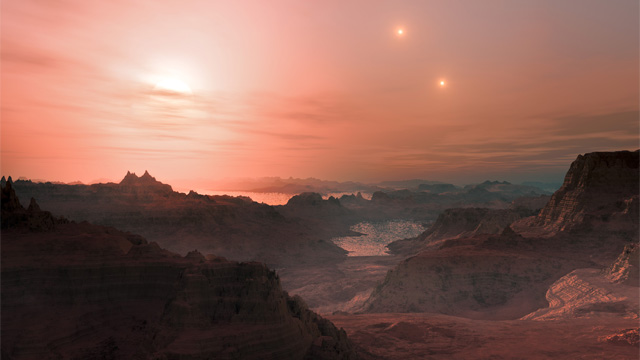Today the count of confirmed exoplanets stands somewhere around 867, with another 2900 or so "candidates" whose existence is waiting to be confirmed. And over 2700 of those candidates were brought to our attention within the past three years by NASA's Kepler mission, whose goal is to find Earthlike planets—Earthlike, in terms of size and habitability potential.
In that mix are seven planets currently touted as potentially habitable—habitable to life as we know it, at least, with conditions that are friendly to the presence of liquid water. It should be noted that this is what scientists mean by habitability: conditions such that liquid water could exist, given an adequate atmosphere and an abundance of water molecules. This definition does not require that a human being could survive in that environment.
Back to Gliese 667 Cc. One of three exoplanets (two confirmed, one candidate) orbiting the red dwarf star Gliese 667 C (one of three stars in a triple star system), this one rates highly on the habitability scale (meaning we can imagine there being oceans, a water cycle, and potentially life), but at the same time is strikingly different in several ways to that prototype of Earthlike planets, Earth.
It is a "super-Earth", meaning, as you might expect, bigger than Earth: estimated at 4.8 times the mass of Earth. Depending on its diameter, that could mean surface gravity notably greater than what we're used to: things weigh more, rain falls faster, landscapes are sculpted with a heavier hand.
It orbits within its star's habitable zone—the proper distance so that water can be in liquid form—but since that star is a red dwarf, and much fainter than the Sun, that proper distance is much closer, about a tenth the Earth-Sun distance. Being so close to its star, Gliese 667 Cc only takes about 28 days to complete an orbit and mark its own year. Imagine a birthday party every month!
It has also been suggested that, since this super-Earth is so close to its star, it is probably tidally locked, rotating only once per revolution and keeping the same face toward its star at all times. This would give Gliese 667 Cc a "day" hemisphere and a "night" hemisphere, so you could choose the time of day you like and stick with it. It would also likely mean a perpetually hot side and a perpetually cold side—unless a thick, Venus-like atmosphere exists that might keep surface temperatures globally similar.
Between these extremes, in the twilight zone between day and night, perhaps would be a perpetually temperate ring bounded on one side by a cold dark vastness of hemi-global ice sheets and a vast realm of sweltering sauna lands and hot-tub oceans--something for every type of vacationer.
And one has to wonder what kind of weather patterns would develop on this schizoid super-Earth.
Such we can imagine. We don't know if Gliese 667 Cc has oceans, or what kind of an atmosphere—if any—it might possess. All we really know is its super-Earth status and location within its star's habitable zone.
Perhaps we'll learn other details in the future that will help us paint a more realistic picture of this exoplanet and get working on that travel brochure.
